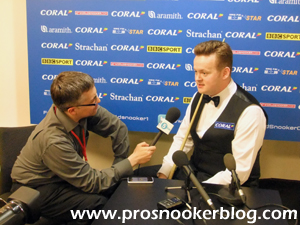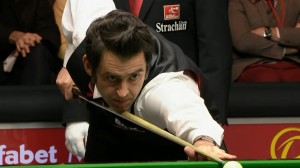
That would appear to be the question, as World Snooker chose the recent Lisbon Open event at which to trial a new system of ‘polishing’ the balls prior to matches, in an attempt to reduce the amount of kicks and bad bounces in the game.
As is ever the case in snooker, feedback was varied, with some praising the conditions and others arguing against the test, particularly at an event carrying ranking points.
Click below for more of the back story and a round-up of the best reactions from professionals on Twitter…
The background
Regular watchers of snooker will be no stranger to the phenomenon of the ‘kick’ whereby either the cue ball or object ball jumps up in the air on impact and generally results in either position being lost, or worse, the pot being missed for the player at the table.
Over the years I have read several theories put forward for kicks, from static electricity to chalk dust, to temperature, but these days it is generally accepted that the scientific cause at least, is the increased friction between the balls when they collide.
Add to kicks the seemingly increased numbers of ‘bad bounces’ from cushions, with balls coming off them quicker than they are going on and it is clear to see that table conditions generally are one of the big talking points amongst professionals at the moment, as demonstrated at the recent UK Championship.

One player particularly concerned by the issue during the past 18 months has been Shaun Murphy, who has undertaken his own research and championed potential measures such as turning the under-table heaters off (saying that they chemically activate the oil content in the cloth that causes the kicks and big bounces), and more recently, advocating the use of the ‘ball cleaner’ or ‘polish’ recommended by ball manufacturer Aramith.
Following particularly vocal criticism of the conditions in York recently, World Snooker this week took the decision to trial the latter suggestion, although perhaps unfortunately, seemingly without telling the players first.
So what has the reaction been like?
In favour
Unsurprisingly, Shaun Murphy was among the players to praise the move, despite his opening round exit to Craig Steadman in Lisbon:
First match of my pro career without any kicks. Thank you @WorldSnooker1 for finally using my ideas to reduce them. Hope they carry on now.
— Shaun Murphy (@Magician147) December 13, 2014
Used correctly, this ball cleaner is the answer. We now need to work out how often it has to be used to work at its optimum — Shaun Murphy (@Magician147) December 15, 2014
Similarly full of praise was Welshman Mark Williams, who having initially left readers wondering whether he was being sarcastic or not, has since repeatedly said that conditions in Portugal were an improvement on recent events:
@WorldSnooker1 polished the balls afrer every match. Well i got to say the tables played perfect all day, not one kick or bounce, #perfect
— Mark Williams MBE (@markwil147) December 12, 2014
@markwil147 @pistol147 @Magician147 I thought the conditions were lovely with the polish, just wasn’t used to it. Hope they continue with it — Martin O’Donnell (@TheMOD147) December 15, 2014
It was a great to play all day yesterday and not get 1 kick or 1 bounce, @WorldSnooker1 . — Mark Williams MBE (@markwil147) December 13, 2014
Event finalist Matt Selt was another to give the conditions the thumbs up…
Anyone moaning about the polish on the balls needs to work on their cue ball control
— Matthew Selt (@MattSelt) December 15, 2014
As well as Mark King, who played three matches at the event before losing out to Mark Davis at the last 32 stage:
I gotta say that the ball cleaner made it better conditions and hardly any bounces and very few small kicks rather than explosions. #cleaner — mark king (@markking147) December 15, 2014
Against
Not everyone was so keen however, Michael Wasley deeming polish not the be the answer:
@ProSnookerBlog world snooker chose to persue one mans opinion. Polish isn’t the answer. Too many variables and inconsistencies. #fact — Michael Wasley (@MichaelWasley) December 15, 2014
As was a common theme, some were not just unhappy with the decision to trial the polish, but more the fact that they weren’t given notice and therefore the ability to practice using the product leading up to the event:
Don’t agree with the polish on the snooker balls especially when 99% of the players didn’t know about it. @Magician147 #madness — chris melling (@chrismelling1) December 15, 2014
@jasonferguson5 think it was a really poor decision to test this new polish in a major event!#impossibletooplay — RobertMilkins (@RobertMilkins) December 12, 2014
That was bad to say the least Probably the hardest table and balls i’v come across, this polishing nonsense is not good, why do it? — Andrew Pagett (@AndrewPagett) December 13, 2014
@porky993 @RobertMilkins react more, if we practice with polish then it wouldn’t be a problem but they surprised us to say the least — Andrew Pagett (@AndrewPagett) December 13, 2014
@alan_mcmanus using the aramith ball cleaner before every match, balls r really skiddy, hard to control position or judge pots with side — fraser patrick (@fraserp147) December 13, 2014
@alan_mcmanus never warned us beforehand so everyones guessing basically. Need to find out if sames happening for german q’s — fraser patrick (@fraserp147) December 13, 2014
@WorldSnooker1 @jasonferguson5 WS excelled again. Next time you conduct an experiment let me know, I’ve got a mortgage to pay! #joke — Michael Holt (@hitmanholt) December 13, 2014
@MichaelWasley @ProSnookerBlog @CueTracker_Ron It completely changes how the balls react though! I’d rather have the odd kick.
— Michael Holt (@hitmanholt) December 15, 2014
@Magician147 Can’t happen. As soon as you mess with the sheen on the balls you’re asking for trouble. It was unplayable at times. #madness — Michael Holt (@hitmanholt) December 15, 2014
The Effects
So to a non-player, what does the polish do? What is the effect in practical terms? I asked the question yesterday and was told the following:
@ProSnookerBlog potting angle is different when using side, different reaction off cushions and much more reaction from the White
— Mark Allen (@pistol147) December 13, 2014
@ProSnookerBlog polish the cue ball on a old cloth in the club and you will see the difference, will play like a newer cloth
— Mark Williams MBE (@markwil147) December 13, 2014
The Science
While I am a big snooker fan, science never was my strong point and so I would not profess to be an authority on the subject, but speaking to fellow blogger Roland from Snooker Island earlier today, he offered the following thoughts, as well as linking to a fascinating article on the subject:
“There is a difference between a genuine kick and a badly struck cue ball causing undesired contact (ie cueball isn’t at same level as object ball on contact). That can’t be helped.
“Polish reduces friction but the balls will definitely react differently. The pack will split better, the white will react at a different timepoint, so cue ball control will require different spin/pace to get same position. All minor adjustments but adjustments all the same. The pros will notice this, but that’s because they are used to more friction. It’s all about the length of time the balls are in contact and the amount of grip between balls.
“I think the pro cloths are thinner so it makes the balls bounce more before contact than club cloths. I think as well that stun shots (white doesn’t spin) can kick when the ball rotates 180 degrees (or equivalent like 540, 900 etc) so the chalk mark makes contact with the object ball. But those kicks Ronnie doesn’t get are the ones which aren’t kicks but are caused by the white not being struck parallel to cloth. Also thicker cloths mean less bounce (exaggerate and think carpet, ball won’t bounce as much as on glass).

“So basically the players that are complaining are right, because the balls are reacting differently, but conditions are more “perfect” because they remove a % of friction which they aren’t used to.
“It’s a tough one, I think Aramith who are the main ball manufacturer should be held accountable and develop a coating that has less friction on contact. The other way is to make balls slightly more dense to compensate. But ball manufacturers have a duty to engage in this debate and I don’t see any of them doing so.
“I think the oil from the cloth caused by table heating theory is a red herring personally. Bottom line though is that if enough money was put into research they’d have solved it by now, which is why I would look to Aramith or rival to invest into research and come up with a solution.”
The way forward
So where do we go from here? Should the polish be persevered with at professional events or will its use be a one-off?
No doubt World Snooker and the WPBSA will now seek the opinions of the players who competed in Lisbon generally, as although we have seen a number of public reactions on Twitter, clearly there are a lot more players who experienced the changes who we have not heard from in the public domain.
For now, the polish will not be used at this week’s German Masters qualifiers in Wigan, to the relief of some and frustration of others, but perhaps the key next time will be that the players are better informed beforehand than they would appear to have been here, or perhaps that the system is trialled at a non-ranking event such as the Shoot Out or World Seniors first.
To polish or not to polish?
